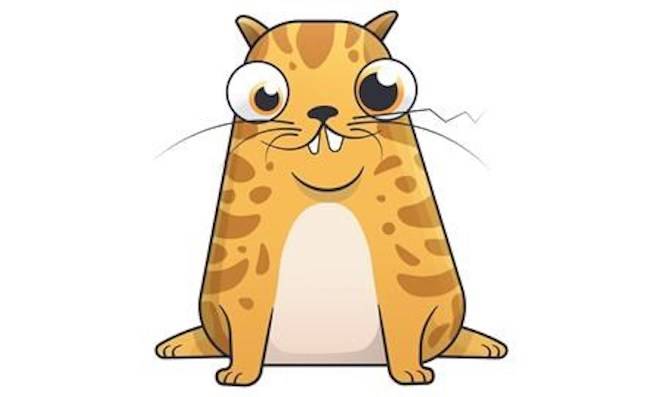At first glance, CryptoKitties are googly-eyed virtual cats that come in an array of fanciful forms — from fluffy ninjas, to feline-duck hybrids.
But don’t underestimate these collectible critters, because some CryptoKitties have commanded six figures on the virtual market, and the B.C.-based company behind the project says it’s attracted more than US$12 million in investments.
And depending on whom you ask, the blockchain-based game is either a sign of where the digital economy is heading, or just another crypto-craze fuelled by the internet’s cat obsession.
For Vancouver-based developer Axiom Zen, it all began with a simple idea, said CryptoKitties communications director Bryce Bladon.
“Let’s put cats on the blockchain,” Bladon recalled a fellow CryptoKitties co-founder saying.
And that, more or less, is what they did.
The result is a virtual game that CryptoKitties, which spun off into its own company in March, has compared to breedable Beanie Babies on the blockchain — collectibles that can be bought, sold and “sired” on the Ethereum network.
When a CryptoKitty changes hands, the exchange is logged by the blockchain, a digital ledger of transactions that is shared among a network of computers.
Every CryptoKitty is encoded with a one-of-a-kind token, which like its digital DNA, determines its heritable traits. When two felines breed, new characteristics — or in the game’s parlance, “cattributes” — can be unlocked through the genetic lottery.
“Ironically, (we’re) trying to be the next Bitcoin by showing that there is a use for this technology beyond Bitcoin.”
A run-of-the-mill virtual kitten costs only a few dollars, but CryptoKitties of special pedigree can have exorbitant price tags.
One CryptoKitty was purchased for US$140,000 at a charity auction in May, and others have garnered similarly eye-popping sales in the cryptocurrency ether.
It’s hard to profit off virtual commodities that can be copied and pasted with just a few keystrokes, but Bladon said blockchain technology has given rise to a new phenomenon in e-commerce — “digital scarcity.”
Related: Experts tell feds how Canada can lead in emerging tech field of ‘blockchain’
Related: ‘Mega trends’ set to alter economy, society, security
Blockchains can set limits on how many and what types of CryptoKitties are in circulation. This means limited-edition CryptoKitties are verifiably rare, and thus, more valuable.
As Bladon sees it, this ability to limit virtual supply makes a “true digital economy possible,” because it means crypto-assets can have real-world values.
Still, he noted, CryptoKitties are not financial securities, and he would steer users away from treating them like investments.
Marek Laskowski, co-founder of the blockchain.lab at York University’s business school, said the comparison between CryptoKitties and the short-lived Beanie Babies craze in the 1990s may have been more apt than the crypto-collectibles company anticipated when it previously touted the analogy on its website.
There were more than 1.3 million transactions involving CryptoKitties at the height of the game’s popularity last December, according to the blockchain analytics site Bloxy. But by June, transactions had plummeted by 90 per cent to 114,000.
“People should be skeptical of … investing more money than they’re prepared to lose, especially with these niche, fad-like collectibles,” said Laskowski.
“Once the novelty wore off, I think that folks kind of found other things to do with their time.”
When asked about the prospect of there being a CryptoKitties bubble, Bladon initially said it was “certainly possible,” but later revised that assessment.
“I think we’ve proven at this point it’s not a bubble for CryptoKitties,” he said. “We aren’t nearly as on fire as we were when we launched, and this is by no means an accident.”
Bladon said CryptoKitties is taking steps to reduce its traffic on the Ethereum network, which like other blockchains, can have slow payment processing times.
Given blockchain’s high transaction fees, Laskowski said he thinks the future of this technology will be using these networks to trade assets with underlying value, such as stocks, rather than the code associated with cartoon cats. In fact, he said, users don’t even own the cartoons themselves.
CryptoKitties holds the copyright to all of its feline graphics, but it recently updated their terms of service to allow owners to use images of their virtual pets for certain purposes.
This move reflects a broader push to give users more control over their CryptoKitties, said Bladon, including creating a “KittyVerse” of third-party projects offering more ways to engage with the game, like taking part in cat fights.
Glenn Eggleton, a software developer in London, Ont., is part of the team behind KittyBattles, which allows CryptoKitties to square off in a Pokemon-like arena.
Eggleton, who maintains a herd of around 180 CryptoKitties, said the open-source nature of the game makes him feel less like a player and more like a stakeholder.
“I feel as if you’re owning like a piece of history,” he said. “You’re basically trying to educate and create an entire industry.”
While many CryptoKitties knockoffs, or “copycats,” have sprouted up in recent months, Bladon said most of them are missing a key ingredient in the game’s success.
“Cats are the ambassadors for everything from pharaohs, to your mom’s Facebook page,” he said. “We’re trying to put an idea out there, and I can’t think of a better mascot for it than cats.”
— By Adina Bresge in Toronto
The Canadian Press



